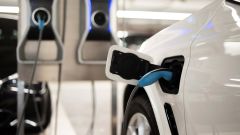E-Mobility

The Transition to E-Mobility
It's been a long time coming, but now it's unstoppable: the automotive world's transition to electromobility. Most people are aware that traffic accounts for a significant share of worldwide CO2 emissions and needs to be reduced. It is also well-known that fossil fuels are not infinitely available. Nevertheless, there are still a lot of questions and much hesitation as to the approach in reducing CO2 emissions in this sector.
Meanwhile, engineers largely agree that the future of powertrain technology belongs to hydrogen, produced using renewable energy sources such as wind and solar. Even if it will take a few years before hydrogen fuel cells begin to power our individual and industrial mobility, a vehicle's powertrain must nonetheless be electrified, since a fuel cell delivers electricity.
This will give rise to entirely new fields of activity – no longer involving mechanical parts such as pistons, crank shafts, and gearbox parts, but those geared towards electrification, mostly using electronic components. And this not only applies to the vehicle side, but to all types of charging stations.
Communication Between Charging Stations and Electric Vehicles, and Beyond
Most electric vehicles are charged using alternating current. As a rule, this involves one phase with 230V and a maximum of 16A, corresponding to approx. 3.3kW. Therefore, charging is accordingly slow, lasting several hours. This type of charging only requires little signalling using a PWM signal.
When charging an electric vehicle with direct current, however, a different approach is followed. In this case, the alternating current is converted to a high-voltage direct current – e.g. to 700V – already at the charging station. As a result, the vehicle's battery is directly charged at very high currents, so that charging stations with 25kW to 350kW are no longer uncommon today. Such high-power charging reduces charging time to just a few minutes. Contrary to alternating current charging, when charging with DC, it is necessary to gauge the battery's charging level, its temperature, and its charging capability, and to transfer this information from the vehicle to the charging station. This in turn requires a safe and well-functioning communication between the two in an extreme environment with possible electromagnetic interference.
Another requirement for the communication between the charging station and the electric vehicle is the secure exchange of identification and billing data.
International ISO 15118 Standard
The International Standardisation Organisation (ISO) has specified these two types of charging communication in its ISO 15118 standard. Its different characteristics were described in separate standard documents:
- ISO 15118-3, for instance, defines the powerline communication for the physical and the data link layer according to the HomePlug Green Phy standard.
- ISO 15118-8 describes wireless power transfer and wireless communication.
- ISO 15118-20 is currently under development. It allows for billing based on "plug & charge" and, contrary to previous billing methods, it no longer requires a smart card or RFID identification. The identification and billing procedure can also be done automatically. ISO 15118-20 will also enable bidirectional charging, also known as "bipolar power transfer". This means that it is both possible to charge the vehicle at the charging station and, if necessary, to return power to the house grid.
In USA, instead of ISO 15118, the previous German standard DIN 70121 and the PWM communication under IEC 61851-1 were converted by the Society of Automotive Engineers (SAE) to the American standards SAE J2847/2 and SAE J1772.
Challenges in the Implementation
The particular challenge for the implementation of communication according to ISO 15118 / DIN 70121 / SAE J2847/2 is to tweak the signal-to-noise ratio to a maximum. Since the transmitting power is stipulated in the standards, this can only be achieved by suppressing noise in PLC implementation to levels between -95 and -100dBm.
CODICO offers a wide range of modules and solutions for these applications, and can support you in all areas of implementation.
Applications in the Area of E-Mobility
Are you looking for the right components to help you implement communication acc. to ISO 15118 / DIN 70121 / SAE J2847/2? Do you need a protocol stack or components for leakage current measurement? Are you interested in Wi-Fi and Bluetooth communication, OCCP 1.6 and/or OCCP as uplink protocol to the backbone, or do you need gate driver ICs optimised for IGBTs, traditional MOSFETs and SiC MOSFETs? As your specialist for e-mobility, CODICO will be happy to support you and offer various solutions catered to your needs.






